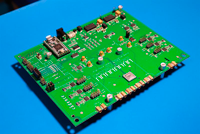 Cadence Design Systems has unveiled the industry’s first silicon-proven, long-reach 112G SerDes IP in 7nm.
Cadence Design Systems has unveiled the industry’s first silicon-proven, long-reach 112G SerDes IP in 7nm. Cadence Design Systems has unveiled the industry’s first silicon-proven, long-reach 112G SerDes IP in 7nm.
Cadence Design Systems has unveiled the industry’s first silicon-proven, long-reach 112G SerDes IP in 7nm.
According to Cadence the IP delivers the power, performance and area (PPA) efficiency required to build high-port density networking products for next-generation cloud-scale and telco datacentres.
Cadence has been working closely with early adopter customers, who have expressed strong interest in this technology and is now ready to engage broadly with customers to enable their next-generation high-performance computing (HPC) ASICs, machine learning accelerators, and switch fabric SoCs.
Escalating mobile data consumption and emerging 5G communications requirements are among a growing number of technical trends that are demanding ever-increasing bandwidth, straining the existing cloud datacentre server, storage and networking infrastructure.
Early adopters are now installing 400G Ethernet ports, with 400G Ethernet expected to go mainstream in 2020 as early adopters begin 800G Ethernet deployment. 112G SerDes technology doubles the data rate of 56G SerDes, meeting the need for high-speed connectivity being driven by emerging data-intensive applications such as machine learning and neural networks.
Based on technology gained from Cadence’s 2017 acquisition of nusemi, the long-reach 112G SerDes supports backplane, copper and optical connections. Among its benefits are:
“The 112G SerDes is a new and critical enabling technology that allows the industry to build out the next-generation 100G, 400G and 800G Ethernet cloud infrastructure more rapidly and cost effectively,” said Lip-Bu Tan, chief executive officer of Cadence. “Our silicon-proven 112G long-reach multi-rate SerDes IP places Cadence at the forefront of high-performance computing system design enablement. By enabling 100Gb/sec per lane, Cadence’s solution reduces the lane count, heat dissipation and cost required to build the next generation of hyperscale infrastructure.”
Author
Neil Tyler
Source: www.newelectronics.co.uk